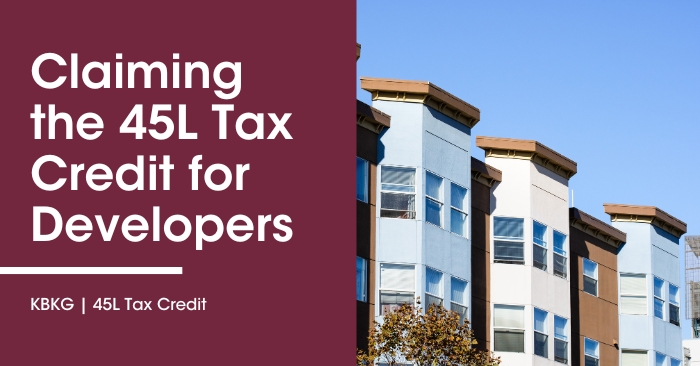Take Advantage of the 45L Tax Credit for Residential Development
Multifamily developers and investors can now qualify for up to $5,000 in tax credits for every energy-efficient dwelling unit they build. The IRS updated its 45L tax credit program in 2023 and is now available to dwelling units within residential buildings of all heights including dwelling units within the low-rise residential buildings eligible in prior years. Partner with KBKG to see if your current or upcoming projects may benefit from this valuable tax credit.
45L Tax Credit Eligibility Requirements
Just as in the past, eligible dwelling units must be leased to tenants or sold to homeowners for use as a residence and both new construction and substantial renovation projects are still eligible. However, eligible dwelling units must now meet a mix of both energy efficiency and construction-related criteria to qualify for 45L tax credits. The process of claiming this incentive also now begins at preconstruction not postconstruction as it has in the past. To maximize the credits, developers must now plan for the credits as early in the design process as possible.
Amount of 45L Tax Credits
Under the new expanded 45L tax credit benefits brought on by the Inflation Reduction Act, multifamily developers can access a credit of:
- $2,500/unit for dwelling units that meet both energy efficiency and construction related criteria.
- $5,000/unit for dwelling units that are solar ready and meet certain indoor air quality measures.
With these changes to the section 45L tax credit, the developer of a 30-unit property could potentially obtain a credit of up to $150,000. For 1,000 units, the available credit amount increases up to $5 million.
Note that these updated amounts apply only to dwelling units leased or sold on or after January 1, 2023. For dwelling units acquired by tenants or homeowners prior to 2023, a credit of either $1,000 or $2,000 can be pursued depending on the property type and the reduction in energy consumption achieved.
Prevailing Wage Requirements
To claim the maximum credit as a multifamily developer or investor, all mechanics and laborers on the project must be paid prevailing wage based on the project type, the type of work performed, and the geographic area of the project.
Expert Consultation for the 45L Tax Credit
To qualify for the 45L tax credit, a detailed energy analysis and certification must be obtained from a qualified third-party verifier like KBKG. KBKG provides the documentation necessary to secure the credit and support the claim in the event of an audit. Our multidisciplinary team of tax experts and engineers serve as invaluable advisors throughout the development, construction, and tax preparation process.
When you partner with KBKG, we’ll work with your team of design professionals and construction experts to ensure the 45L requirements are met and a comprehensive report with all the supporting documentation is delivered to you and your tax preparer. In fact, we’ve already secured millions of dollars in 45L credits for multi-family buildings and developments all over the country. Reach out today to optimize your tax incentives for energy-saving residential construction with KBKG.


